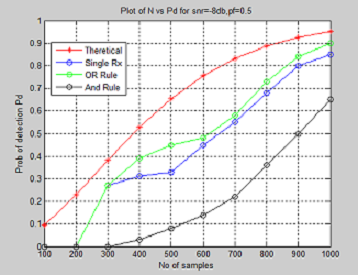


Indian Journal of Science and Technology
Year: 2020, Volume: 13, Issue: 13, Pages: 1355-1366
Original Article
R Aswatha1*, V Seethalakshmi1, K Murugan1, N Sathishkumar1, A Reethika1, S Gunanandhini1
1Department of Electronics and Communication Engineering, KPR Institute of Engineering and Technology, Coimbatore, 641407, India
*Author for correspondence
R Aswatha
Department of Electronics and Communication Engineering, KPR Institute of Engineering and Technology, Coimbatore, 641407, India
Email: [email protected]
Received Date:01 April 2020, Accepted Date:23 April 2020, Published Date:16 May 2020
Objectives: To implement energy detection and eigenvalue based cooperative spectrum sensing in NI-USRP hardware platform and to obtain its performance.Cooperative spectrum sensing is to be implemented using O and AND fusion rules. Methodology: The hardware is implemented using one primary user transmitter and two cognitive radio users. The implementation is done using LABVIEW and detection performance is analyzed. In cooperative spectrum sensing (CSS), CR system shares its own sensing information with other sensing nodes and utilizes the sensing outcomes of others to give a decision. Findings: Energy detection performs well in high SNR region and eigenvalue based detection performs well even with low SNR region. Energy detector detects the signal completely with SNR greater than 10dB. Eigenvalue detector detects signal completely at SNR of -9dB. Detection probability with OR Cooperative rule is better than AND rule. It increases with number of samples and signal to noise ratio. It is found that cooperative spectrum sensing performs well than the noncooperative sensing by decreasing the chances of miss detection. Novelty: CSS is robust in sensing errors due to hidden node or fading channels and also it decreases the probabilities of false alarm as well as probabilities of miss detection.
Keywords: Cognitive radio; Cooperative spectrum sensing; Primary users; Secondary users; Energy detection
Copyright: © 2020 Aswatha, Seethalakshmi, Murugan, Sathishkumar, Reethika, Gunanandhini. This is an open-access article distributed under the terms of the Creative Commons Attribution License, which permits unrestricted use, distribution, and reproduction in any medium, provided the original author and source are credited.
Published By Indian Society for Education and Environment (iSee)
Subscribe now for latest articles and news.